What is the Kratky Method of Hydroponics?
The Kratky method is a hydroponic method where the plants grow in water rather than in soil. It is probably one of the simplest hydroponic methods and is perfect for those living off the grid because it takes no electricity at all. What makes the Kratky method unique is its simplicity. There is no aeration, no water movement, and generally no reason to change the nutrient solution if you have set everything up correctly and you are only growing leafy greens.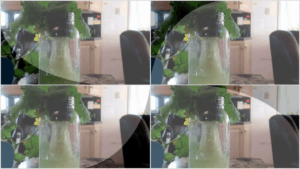
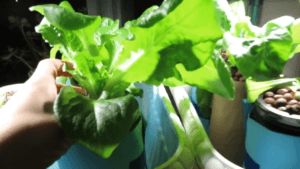 If you are growing flowering or fruiting plants, then you will need to add nutrients and water as it is used up by the plant. The pure form of the Kratky method does not call for adding more water or nutrients. It is a more set it and forget it method.
If you are growing flowering or fruiting plants, then you will need to add nutrients and water as it is used up by the plant. The pure form of the Kratky method does not call for adding more water or nutrients. It is a more set it and forget it method.
How Well Does the Kratky Method Work?
Here are some lettuce plants grown using this method. Arugula is an excellent green to grow as it grows very quickly. The Kratky method is an excellent method for growing leafy green vegetables. Fruiting plants are a little more difficult but it can be done.
Here’s a cucumber plant. There are flowers starting to develop on this plant after three months of growing in this container and here are the tomato 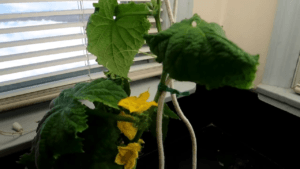 plants – but more about this later.
plants – but more about this later.
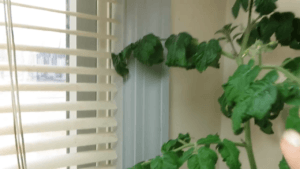 So basically the Kratky method is a method of growing plants in water without any special equipment. It was developed by Bernard Kratky from the University of Hawaii. He called it a “non-circulating hydroponic method” but has now become universally called the Kratky method.
So basically the Kratky method is a method of growing plants in water without any special equipment. It was developed by Bernard Kratky from the University of Hawaii. He called it a “non-circulating hydroponic method” but has now become universally called the Kratky method.
The Simplicity of the Kratky Method of Hydroponics
So how does it work? Well, to get started, you need a plant or a small seedling. I usually start my seedlings in Rockwool. Below you can see what Rockwool looks like. As you can see it come in small cubes with holes to put the seeds in. This package has one and a half-inch cubes. They come in different sizes but I find this size works for my uses here.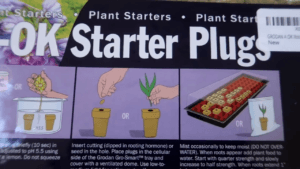
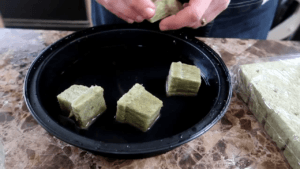 Rockwool is made from basalt, rock, and chalk that are melted at 1600 degrees Celsius into lava, which is then pulled into cotton candy-like fibers. The fibers are then compressed into these cubes. The high temperature that produces the Rockwool renders it sterile, so it is perfect to use as a growing medium. You will need to soak the Rockwool in water until it is saturated and then just drop a seed down the hole.
Rockwool is made from basalt, rock, and chalk that are melted at 1600 degrees Celsius into lava, which is then pulled into cotton candy-like fibers. The fibers are then compressed into these cubes. The high temperature that produces the Rockwool renders it sterile, so it is perfect to use as a growing medium. You will need to soak the Rockwool in water until it is saturated and then just drop a seed down the hole.
Once you have seedlings as you see here, you are ready to transplant.
How to Plant Using the Kratky Method
Now, if you’re using traditional planting methods, this is where you would put the plant into soil, but not with the Kratky method.
 We take the young seedling in its Rockwool cube and plant in water. Instead of using a net cup like this, you can you’re your own net cups using plastic drinking cups, but these are easily available on Amazon and are not expensive. I have them in two sizes.
We take the young seedling in its Rockwool cube and plant in water. Instead of using a net cup like this, you can you’re your own net cups using plastic drinking cups, but these are easily available on Amazon and are not expensive. I have them in two sizes.
Here you can see the two-inch net cups for smaller plants. These fit nicely into the smaller Mason jars and are perfect for my lettuce plants. You can also see the three-inch net cups that fit into the larger Mason jars and also fit perfectly into this Folgers coffee container. When I found out that the three-inch net cups fit into the Folgers containers, I was very excited.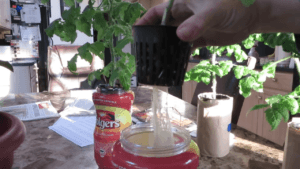
These containers have a small little window so I can check up on the water level and they are larger for my larger plants. What a great way to recycle!
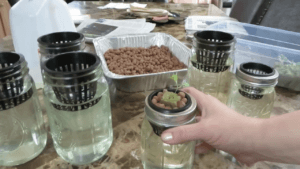 Still in the rock wool, I put some clay pebbles around the Rockwool to fill in the empty space and to keep light from getting down into the water. The clay pebbles are not necessary, but they do add stability to the Rockwell cube in the net cup. Now I placed the entire net cup into a jar or some sort of reservoir filled with water.
Still in the rock wool, I put some clay pebbles around the Rockwool to fill in the empty space and to keep light from getting down into the water. The clay pebbles are not necessary, but they do add stability to the Rockwell cube in the net cup. Now I placed the entire net cup into a jar or some sort of reservoir filled with water.
Mixing Nutrients for Your Plants
The water has a hydroponic nutrient solution to help feed the plants the nutrients they would normally get from the soil. For my lettuce plants, I use the Grow Big Hydroponic solution from Fox Farms. It is really easy to mix. Just shake and add two teaspoons to a gallon of water.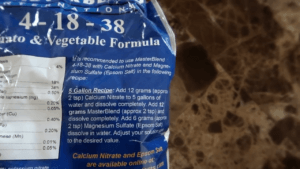
For fruiting or flowering plants like cucumbers or tomatoes, I prefer the Masterblend formula. This is a little more complicated since it has three parts to be mixed. Also, the recipe on the bag gives the amount to be mixed into five gallons of water, which is far too much for my needs.
So I use a kitty litter plastic container and measure two gallons of water into it and then add half of the recipe called for. So, following the recipe at half the measurements, I add the six grams of calcium nitrate, first. Then I mix it with the water so that it dissolves completely and then I add six grams of the Master Blend 4-18-38 formula and dissolve that completely. Next goes in the three grams of magnesium sulfate (or Epsom Salts) and again dissolve it completely. Now it’s ready to be added to whatever containers I am using – in this case, the glass Mason jars.
 When first transplanting the seedlings, the water level should be to the bottom of the net cubes. As the plant grows, it will drink up the nutrient-rich water and the roots will grow down into the water as you see below. As the water level goes down, the plant will put out what are called air roots and these roots help feed the plant the oxygen that it needs.
When first transplanting the seedlings, the water level should be to the bottom of the net cubes. As the plant grows, it will drink up the nutrient-rich water and the roots will grow down into the water as you see below. As the water level goes down, the plant will put out what are called air roots and these roots help feed the plant the oxygen that it needs.
Don’t Drown Your Plants!
That’s why with this method, you don’t need an air pump. Now, if you are growing lettuce or leafy greens, this method is perfect because, by the time the water is used up, the leafy greens will be ready for harvesting. However, if you are growing fruit or flower-bearing plants they take longer and so the water will need to be replenished. When you do that, you risk drowning the plant.
If you refill the reservoir level too high, make sure when you refill it to leave a good two inches of space for the plant roots to breathe. This is the 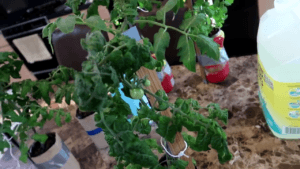 number one reason plants die after the water level is replenished.
number one reason plants die after the water level is replenished.
The plant’s main roots should be long enough to reach the water and the plant’s air roots should stay out, otherwise, you will drown your plant.
The cucumber plant is flowering and will soon produce cucumbers. Here you can see the tomato plants that have also started to flower and even have two little tomatoes on them. In addition, there is the lettuce that just keeps growing and growing!
Conclusion – What is the Kratky Method of Hydroponics?
The Kratky method of hydroponics takes no moving parts, no electricity and can be built on easily recycled or inexpensive materials. It’s great for those of us that are trying to get back to our roots and just plain don’t want to spend buckets of money growing food! You will see the basics you might want to buy on the Amazon site strip below but this system can be set up for $20 or less. I love this system because of its ease of use and the set it and forget it method. I think you will love it to!
Don’t forget to share and follow my posts! I would love to hear from you in the comments section below!
Related Posts
Conventional vs. Organic Hydroponic Nutrients


0 (0) Are “Organic” nutrients really better for your system or for your customers? Find out in this video from…
Can You Profit From Hydroponics?
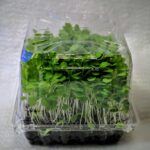

5 (8) Did you hear the story of a farmer who started growing strawberries? Yes? But, do you know he…


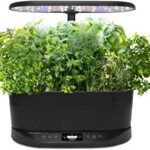

Hello ,
Thanks for allowing me to read your post on “What is the Kratky Method of Hydroponics this off the grid plan growing concept is truly amazing. Until I wasn’t familier with rockwood cubes but it really help to see the picture of this entire process. I live in a part of the world where Kratky Method of Hydroponics could really benefit me in the fall and winter times of the year. It seems affordable and this is certainty something others in my area can use.
Best Regards
Audrey
Hi Audrey, yes, most of the things you need could easily be made from things around the house and repurposed or recycled. Even if you bought everything from Amazon, it would still be very cheap. I hope you have delicious greens all winter long!
The Kratky Method seems simple to use to grow lettuce. I think when I attempt to grow lettuce over the next few months, I’m going to go with the Kratky method. I like that it doesn’t require much work, electricity and you can pretty much forget about it! I’m so used to growing leafy greens in soil, so it’ll be interested to see what the results will be with this method.
It really is the simplest method. You water it once and let it go. By the time the jar is out of water, your lettuce is ready to be harvested. Its a great way to set it and forget it!
Thank you for this article, I found it very informative. My dad has quite the green thumb and has passed that on to me. My mom however, can’t keep anything green for very long, much more brown. I think if I can get some new plants and put them in a Kratky method hydroponic setup, she might be able to keep a set of her own plants that my dad doesn’t have to save. I will just have to remind her to check the water levels every now and then.
I have never heard of Rockwool before today. That seems to be a really easy way to ensure more of my starts make it past their sprouting phase. Defeneftly going to be working out a hydroponic setup soon, thank you for the inspiration from this post!
Thank you, Kenny! I am so glad you liked it! I really do think your Mom could do this because once the plant has used up all of the water in the Mason jar (if its a leafy green) then its time to be harvested and to start over! There’s very little chance of it running out of water and dying before it gets eaten! Enjoy!
Who knew there was so much to learn about hydroponics?! I’ve been looking into growing a few things indoors (especially tomatoes) in the off season. This looks like an easy and affordable way to get started and try it out to see if I like it. I see that you are growing tomatoes…but I can’t tell what size container you’re using. Is that just a Mason jar, too?
Hiya Katie, Actually, that is in one of the coffee containers as they are a bit larger but it could easily live in a large mason jar. This method truly is the easiest way to do hydroponics!
Thank you so much for this article! This was such an interesting read as my sister’s house is full of plants and she is finder it harder and harder to maintain them. I will pass this method on to her so that her plants can stay alive and thriving. I have also been getting into the idea of indoor gardening and am excited to try this method. I feel like indoor gardening niche is growing and I am excited to see where it goes. I look forward to reading more!
Your sister’s plants may just need some nutrients. Check out my article on having a worm bin for nutrients in soil plants or try putting a bit of these nutrients into them to give them a boost. If plants are left in the same soil year after year, the soil will get depleted and the plants will suffer. I hope you give it a try, too! All the best, Hillary!
Excellent article!
I read the entire post and it seems super simple that anyone could do it. I have a couple of questions – if aeration is not necessary, what then is the purpose of water circulation in hydroponics? Also, if the water is stagnant, will it not grow mold or mildew especially if exposed to the sun?
Sunny
Hiya Sunny, Even though the water is stagnant, it is being used up quickly by leafy green vegetables that only take about a month to grow. If algae growth is a problem in your Mason jars, just cover them with paper or paint them but try to keep a line where you can see the water level! Frankly, I find that quick-growing greens use the water up so quickly that I’ve never had a problem with algae. In normal hydroponics, the water level is kept up to a certain level and so needs to be aerated. With the Kratky method, as the water level drops, the plant grows air roots in order to aerate itself.
Hey, I enjoy a lot while reading your article and find it very useful for everyone like me. Now I know that the Kratky method is a hydroponic method where the plants grow in water rather than in soil. It is probably one of the simplest hydroponic methods and is perfect for those living off the grid because it takes no electricity at all. What makes the Kratky method unique is its simplicity. The plant’s main roots should be long enough to reach the water and the plant’s air roots should stay out, otherwise, you will drown your plant. Thanks for sharing such useful guide.
I am so glad you found this useful. The plant will naturally grow roots that “chase” the water as it lowers and at making air roots for proper aeration. This is a great method and if you have a really sunny window, you probably don’t even need lights!
Honestly, I find it hard to follow and keep up with the instructions given. Maybe because I’m new to this Hydrophonic way of planting so forgive me for being slow to learn. But I am determined to learn this method as I need more green leafy vegetables and I vowed to myself to master this craft. To supplement my learning of this method, can you suggest me to a free guide or maybe a PDF ebook or report that contains all these and can be read offline via a mobile device?
Hi Gomer, There have been tons written on this topic. There are Facebook groups devoted to it. You can Google it and there is plenty on YouTube. Give Amazon a try for actual books or e-books. I know you will find tons of information!
Thank you for your post. It is useful for me. We live in the New York state and have garden. We enjoy the fresh vegetables in the summer, but in the winter it is not possible to grow them. We think about the possibility of growing vegetables in the winter, but never take time to do the research.
Here comes your article. It is so nice to see that the Kratky method is an excellent method for growing leafy green vegetables. From your description, it is also possible grow cucumber and tomato. With these, we could certainly enjoy the fresh vegetables in the winter.
Another nice thing about the system is that we could establish the system without any special equipment. I bookmarked your webpage and will learn more from it. I am going to initiate this project this year and by the coming winter I wish we could have fresh vegetables to enjoy.
Thank you Anthony! Yes, this site is just for people like us who cannot grow veggies outside during the winter. I am from Nova Scotia Canada and I can’t see any reason for paying the sky-high prices for fresh greens in the markets here in the winter. Homegrown is better for you and leaves almost no carbon footprint.
Thank for for sharing such a detailed post about the kratky method of hydroponics. The Kratky method is no doubt a simple and relaxing way to try with Hydroponics. If I am to recommend a simple easy-to-build system for beginners and kids, the Kratky system will definitely be one of them also thanks for the amazon recommended really makes things easier.
Thank you Patrick. Yes, this would be an AMAZING way for kids to get started with hydroponics. Its simple and inexpensive and it works! Best the best!
hello, it is a great and nice feeling to know that someone will create a great website like this and also create a write up on an article like this. i have actually seen this hydroponic method before but i did not pay much attention to it. i am glad i can fully understand it and utilize it. thank you
Hi Barry, I really do hope that you enjoy this message and that you get lots of use out of it. Wishing you lots of luck and lots of produce. Have a great day
Oh wow never heard of the Kratky systems before. Thank you for sharing this system. I have tried doing an aquaponic system with fishes and a hydroponic systems to no success. It seems like this system is worth looking into since it’s not very complicated.
And it seems like I already have most of the system at home. Just need some holding net and am good.
Thank you I’ve learned something new today. Now I know why my plants died after I transplant them. I drowned them.
LOL – No drowning plants allowed! Just joking!
The Kratky method is most definitely one of the easiest and cost-efficient systems out there.
If you are looking for systems that will grow more plants, I would suggest checking out https://myindoorgrowsystems.com/aeroponic-grow-systems-indoor-growing-and-more-with-aerogarden/ or https://myindoorgrowsystems.com/ebb-and-flow-hydroponic-systems-go-vertical/
Check out the rest of the site for some other amazing ways to grow plants for food or profit on this web site and I wish you happy growing!